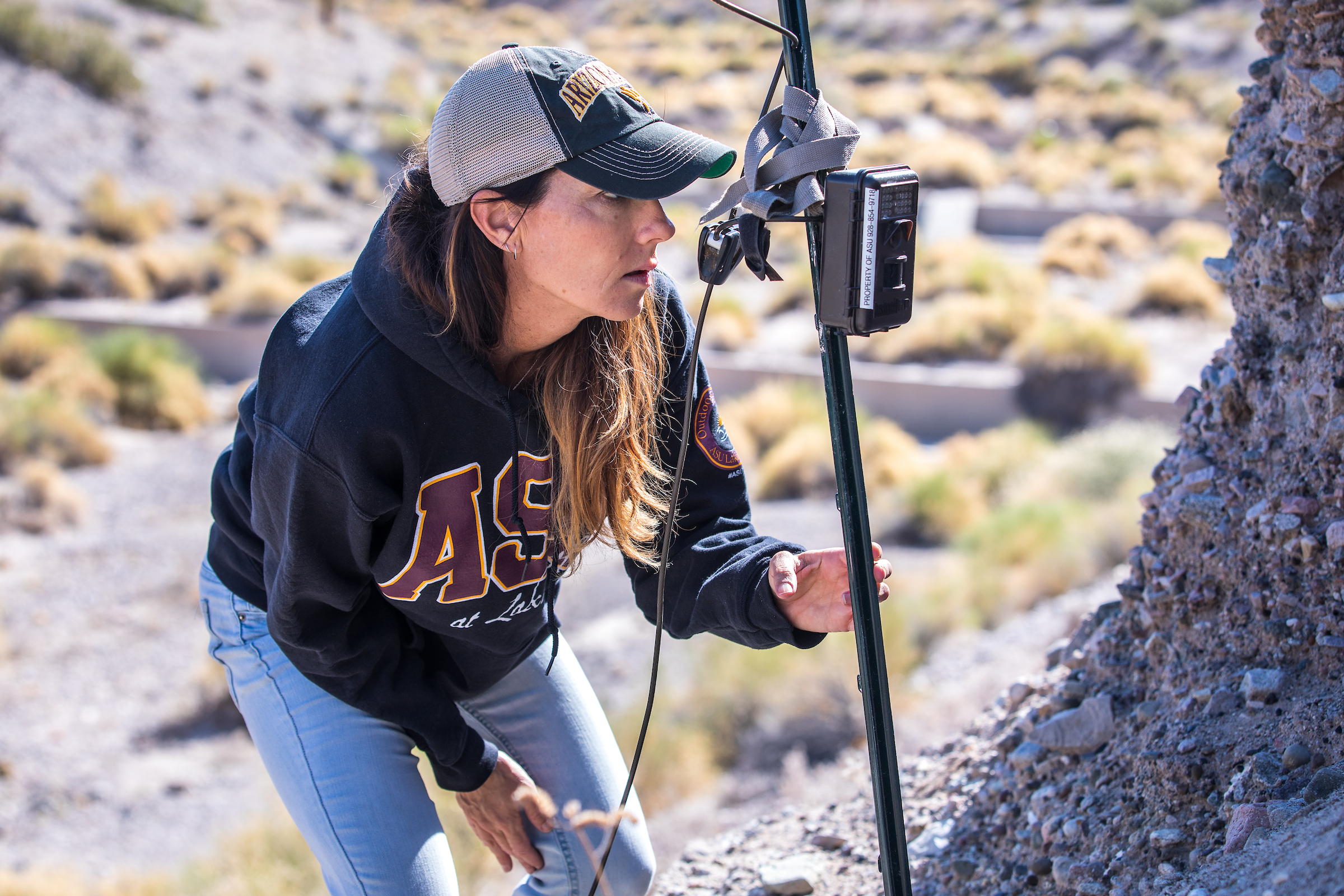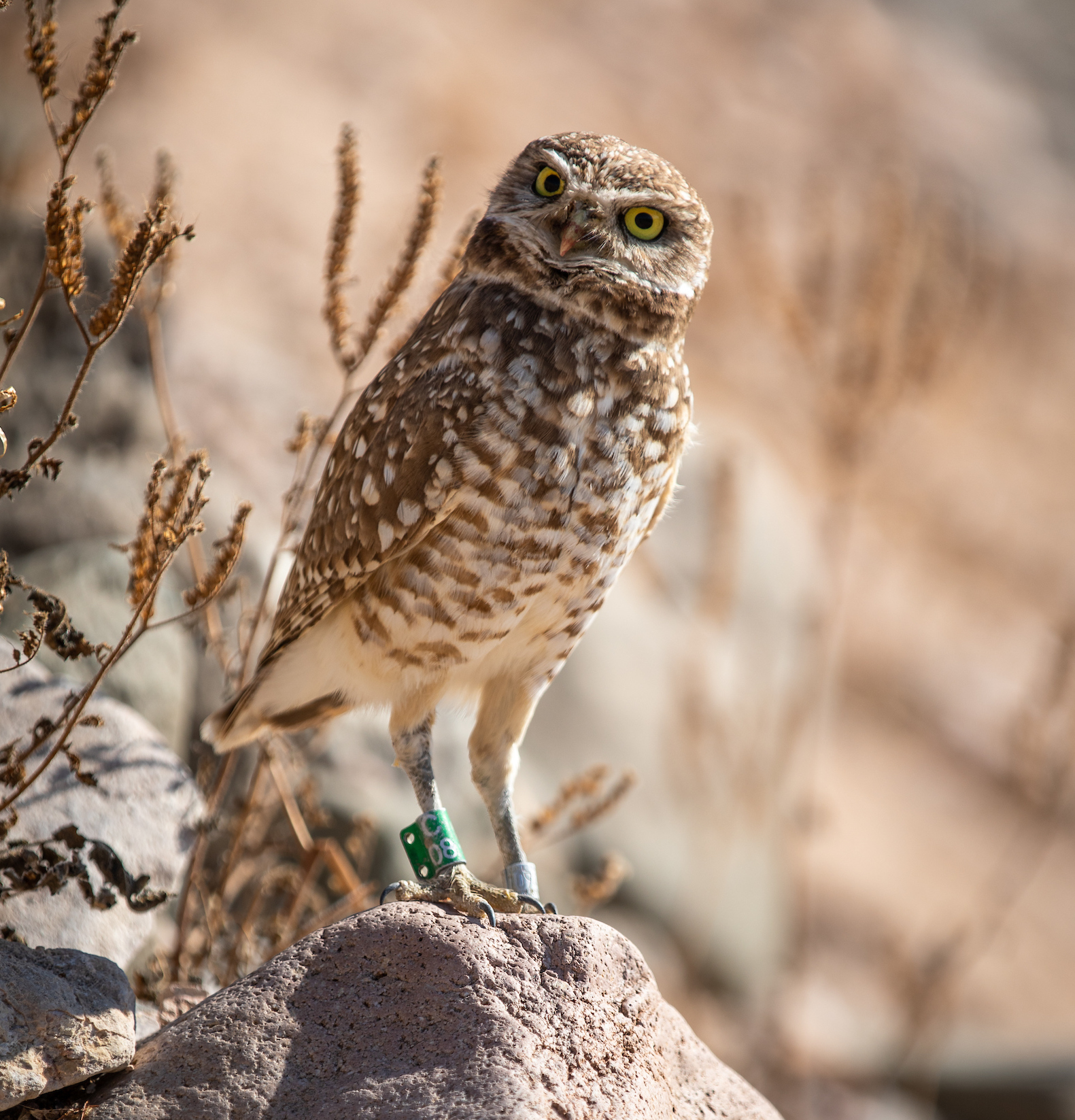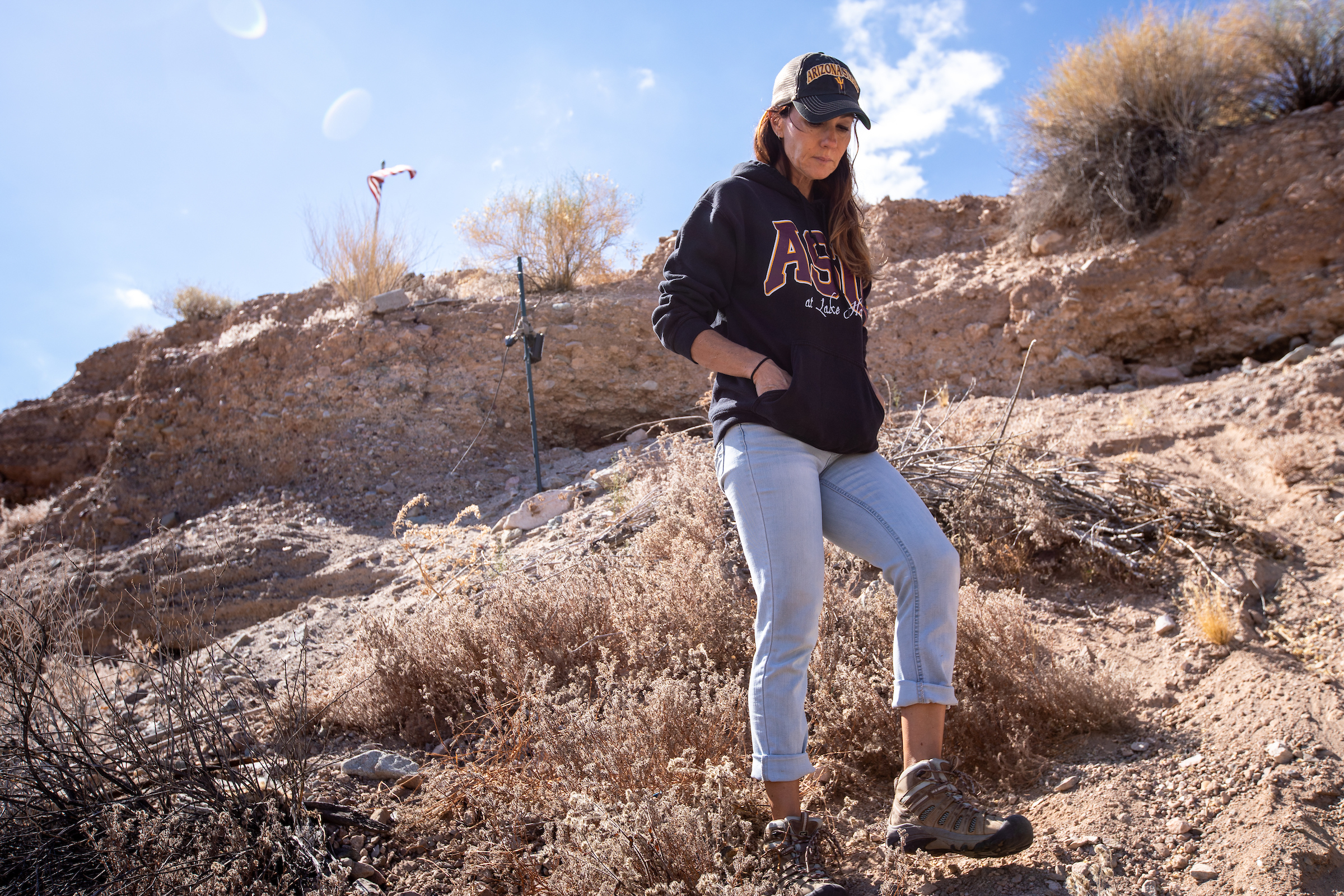The western burrowing owl is like no other bird: It lives underground, is adaptable to urban environments and its idea of a show of force is to surround its nest with dog waste and neighborhood trash.
These are just some of the nesting and habitat characteristics brought to light by Kerrie Anne Loyd, a wildlife biologist at Arizona State University at Lake Havasu.
The ongoing research, now in its sixth year, will fill in important gaps in knowledge about owl activity and population trends in human-dominated environments.
“I love birds, and my objective is to help people get along with wildlife,” said Loyd, whose work on domestic cats and wildlife has been highlighted on "NBC Nightly News," NPR’s "All Things Considered" and ABC’s "20/20." “By studying animals and helping to understand their habits, I can find what they need in order to thrive in human-dominated environments.”
Kerrie Anne Loyd sets up a movement-triggered camera outside one of the burrowing owl habitats in Lake Havasu City on May 24. The urban/suburban ecologist is gathering data as part of her research on the owls funded in part by the Arizona Game and Fish Department. Photo by Charlie Leight/ASU Now
Loyd began studying the bird, which stands about 10 inches tall and has round, yellow eyes and long, skinny legs, in 2013. For decades their numbers were declining across western North America due to loss of natural habitat and lethal control of burrowing rodents. The birds shifted to more developed habitats such as agricultural areas, golf courses and undeveloped lots. In Lake Havasu City, they set up house in desert washes, using existing burrows created by ground squirrels and wood rats.
Because of their proximity to humans in Lake Havasu City, these raptorsA carnivorous medium- to large-size bird (such as a hawk, eagle, owl or vulture) that has a hooked beak and large sharp talons and that feeds wholly or chiefly on meat taken by hunting or on carrion. seem more naturally tolerant of people.
“They’re super charismatic because they’re cute, out during the day, easy to see and fun to watch,” Loyd said. “People in town have an interest in them and can get up close to them. The owls don’t find observant people a threat.”
However, Loyd said, if someone gets too close to a nest while the birds have babies, usually in May and June, they could feel the sting of a parent’s talons. Loyd herself has felt those at times, spending close to 20 hours a week conducting research at nest sites.
Loyd’s director said her research is important to the species, the city and the 6-year-old ASU location.
“Kerrie Anne Loyd’s success in acquiring research funding for her burrowing owl and domestic cat studies reinforces the notion that faculty at rural campuses like ASU at Lake Havasu are also making strong contributions to their fields,” said Raymond Van der Riet, director of ASU at Lake Havasu. “The landscape and environment surrounding ASU at Lake Havasu offer the perfect field laboratory for applied research.”
Loyd and a team of ASU students have monitored 136 active nests within the Lake Havasu City limits over a six-year period through the use of remote cameras and on-site fieldwork. Briana Morgan, a 2016 ASU graduate, worked alongside Loyd for three years.
“Through Kerrie Anne’s work, I truly learned the impact that humans have on wildlife and the environment,” said Morgan, who today is a water conservation specialist for Lake Havasu City. “The best word I would use to describe her is dedicated. She’s 100% dedicated to her research, and her passion influences her students without pushing it on them.”
Among Loyd’s key findings:
- A burrowing owl family is estimated to eat up to 1,800 rodents and 7,000 arthropods (scorpions and beetles) in a single summer.
- Nest success averaged 70% from 2014 to 2018, and the average number of juveniles produced was 4.2.
- Burrowing owls are opportunistic hunters and prefer small mammals and arthropods.
- In addition to Loyd’s research, there are only five studies on burrowing owls in urban/suburban locations.
- Owls live in Lake Havasu City year round, but north of Arizona they are migratory and usually head to Mexico for the winter.
A movement-triggered camera outside of a burrowing owl habitat in Lake Havasu City helps to inform the research ASU biologist Kerrie Anne Loyd, who has been studying the raptor since 2013. Photo by Charlie Leight/ASU Now
One of her most important discoveries was that the primary cause of owl mortality in Lake Havasu City was due to increased use of pesticides in an attempt to remove mice, rats and ground squirrels. Loyd said that 24 owls in one year experienced secondary poisoning through consumption of rodents contaminated with rat poison. Dogs, cats and other birds can be unintended victims as well.
That particular finding led ASU, Arizona Game and Fish and Wild at Heart to support a combined “owl-friendly” educational campaign in Lake Havasu City. This included the distribution of 6,000 brochures and three permanent interpretive signs, asking community members and residents to be vigilant about use of rat poison and encourage other methods of pest control.
The western burrowing owl is listed as a species of conservation concern in Arizona and its numbers are declining, but the birds seem to be thriving in Lake Havasu City.
Much of the credit should go to Loyd, said an associate.
“Kerrie Anne’s research and her ability to convey that to the public has helped immensely with the owl population,” said Pam Smart, founder of Havasu Wildlife Rehabilitation, a nonprofit that helps wounded and abandoned animals. “Before Kerrie Anne came here, I don’t think the concern and the visibility of the owls was there. She’s helped a great deal in getting the word out.”
But there are some questions that Loyd doesn’t have the answer to. Like why do the male owls spend an inordinate amount of time and energy decorating their nests with dog waste, which can often attract predators like dogs, roadrunners and coyotes?
Loyd believes the male owl is simply marking his territory.
ASU at Lake Havasu City wildlife biology senior lecturer Kerrie Anne Loyd spends up to 20 hours a week doing on-site research. Photo by Charlie Leight/ASU Now
“The hypothesis is now that the owl is stating, ‘This spot is occupied. I’m the best bird in the neighborhood because look at all this energy I have to gather dog poop and trash to put around my nest!’” Loyd said.
The current phase of Loyd’s research, which will continue at least through 2020, is focused on dispersal distances of juvenile birds and behavior of adults at nest sites year to year. She will also continue to work on public education efforts to ensure long-term population growth.
“I’m so lucky to be able to study such an interesting species and involve so many students in conservation research right here in our small desert city,” Loyd said. “It’s been a fun project to do.”
Top photo by Charlie Leight/ASU Now
More Science and technology

ASU-led space telescope is ready to fly
The Star Planet Activity Research CubeSat, or SPARCS, a small space telescope that will monitor the flares and sunspot activity of low-mass stars, has now passed its pre-shipment review by NASA.…

ASU at the heart of the state's revitalized microelectronics industry
A stronger local economy, more reliable technology, and a future where our computers and devices do the impossible: that’s the transformation ASU is driving through its microelectronics research…

Breakthrough copper alloy achieves unprecedented high-temperature performance
A team of researchers from Arizona State University, the U.S. Army Research Laboratory, Lehigh University and Louisiana State University has developed a groundbreaking high-temperature copper alloy…






